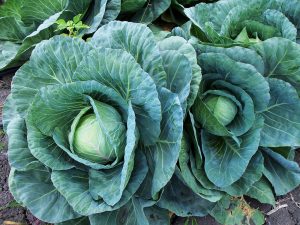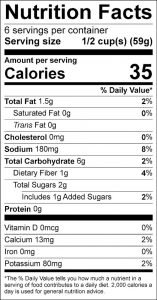Bulletin #4182, Vegetables and Fruits for Health: Brussels Sprouts and Cabbage

Updated and revised by Extension Professor Louise O. Kirkland, University of Maine Cooperative Extension.
Originally developed by Extension Nutrition Specialist Nellie Hedstrom, University of Maine Cooperative Extension.
For information about UMaine Extension programs and resources, visit extension.umaine.edu.
Find more of our publications and books at extension.umaine.edu/publications/.
Brussels sprouts are the newest member of the cabbage family. The leaves are on the top of the plant and the tiny heads completely surround the stalk. These heads resemble tiny cabbages. There are several types of cabbage: red cabbage; green, crinkly-leaved Savoy cabbage; green, smooth-leaved cabbage; and green-leaved Chinese cabbage. Maine-grown cabbage is plentiful from June through December.
Nutrition Information
The scientific name for the group of plants that includes Brussels sprouts and cabbage is cruciferous. Scientists use this term to identify plants whose blossoms resemble a cross. The group of vegetables that includes cabbage and Brussels sprouts may help prevent cancer. Both cabbage and Brussels sprouts are also good sources of vitamin C. (However, one serving of Brussels sprouts provides more than twice the vitamin C provided by an equal amount of cabbage.) Brussels sprouts are also a good source of vitamin A and potassium.
Selection
Brussels Sprouts: Choose sprouts that are firm and compact and have a good green color. Avoid sprouts that look puffy, wilted, or yellow.
Cabbage: Choose solid, fresh-looking heads that are heavy for their size. The outer leaves should be smooth, with good color (deep green or deep red, depending on the type). Avoid wilted or yellow cabbage.
Storage
Brussels Sprouts: Store unwashed and covered in the refrigerator. Use within three to five days.
Cabbage: Store in a plastic bag or container in the refrigerator. Unwashed cabbage heads will keep in the refrigerator for up to two weeks.
Preparation
Brussels sprouts and cabbage contain the mineral sulfur. When these vegetables are cooked, the sulfur is released and an unpleasant odor is produced. The longer you cook these vegetables, the more sulfur is released. To reduce the smell, cook vegetables quickly.
Preparing Raw Cabbage:
Remove damaged or wilted outer leaves. When making coleslaw (see recipe), shred the cabbage a short time before serving. (Exposure to air will destroy vitamin C.)
Steaming:
Brussels sprouts: Rinse well and trim stems. If you cut a cross in the bottom of each stem, the sprouts will cook more quickly. Steam 15 to 20 minutes.
Cabbage: Remove damaged or wilted outer leaves. If cut in wedges, steam ten to 15 minutes. If shredded, steam three to eight minutes.
How to steam: Bring one inch of water to boil in the bottom of a pan. Place a colander or a collapsible steaming basket in the pan. Then put the vegetables in the colander or steamer and cover it tightly. Reduce heat to medium-low, but make sure it is high enough to keep the water bubbling.
Microwaving:
Brussels sprouts: Remove loose leaves. Trim each stem and cut a cross in the bottom to speed cooking. Arrange one pound (4 cups) in a 1 1/2 quart covered dish. Add 1/4 cup water. Microwave for four to eight minutes on high power until tender (easily pierced with a fork) Stir once during cooking.
Cabbage: Place one pound (a small head) of wedges in a covered dish with two tablespoons water. Microwave four to six minutes. Stir once.
Note: For red cabbage, also add two teaspoons of vinegar.
Brussels Sprouts with Scallions
Serves 4
This dish is an excellent source of vitamin C, a good source of vitamin A, and a source of iron. It is also low in sodium and cholesterol.
1 pound Brussels sprouts
1 tablespoon margarine
4 scallions, thinly sliced
1 tablespoon lemon juice
black pepper
Steam Brussels sprouts until tender. Drain well. Meanwhile, melt margarine in a skillet and sauté scallions until tender. Add the cooked Brussels sprouts to the pan and stir to blend the vegetables. Add lemon juice and pepper (to taste).
Crispy Coleslaw
Serves 6
This recipe is rich in vitamins A and C.
2 cups shredded cabbage
1/3 cup grated carrots
1 teaspoon minced onion
1/3 cup diced green peppers
Dressing:
1/2 cup lowfat mayonnaise
1/4 teaspoon paprika
1 teaspoon sugar
1/2 teaspoon vinegar or lemon juice
sliced tomato for garnish (optional)
Shred cabbage and grate carrots; mix with onion and green peppers. Combine remaining ingredients for coleslaw dressing in a separate dish. Mix cabbage mixture with dressing and toss lightly. Garnish with sliced tomato.
Some content adapted with permission from University of Massachusetts Cooperative Extension.
Information in this publication is provided purely for educational purposes. No responsibility is assumed for any problems associated with the use of products or services mentioned. No endorsement of products or companies is intended, nor is criticism of unnamed products or companies implied.
© 2008
Call 800.287.0274 (in Maine), or 207.581.3188, for information on publications and program offerings from University of Maine Cooperative Extension, or visit extension.umaine.edu.
In complying with the letter and spirit of applicable laws and pursuing its own goals of diversity, the University of Maine System does not discriminate on the grounds of race, color, religion, sex, sexual orientation, transgender status, gender, gender identity or expression, ethnicity, national origin, citizenship status, familial status, ancestry, age, disability physical or mental, genetic information, or veterans or military status in employment, education, and all other programs and activities. The University provides reasonable accommodations to qualified individuals with disabilities upon request. The following person has been designated to handle inquiries regarding non-discrimination policies: Director of Equal Opportunity and Title IX Services, 5713 Chadbourne Hall, Room 412, University of Maine, Orono, ME 04469-5713, 207.581.1226, TTY 711 (Maine Relay System).



